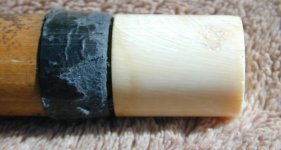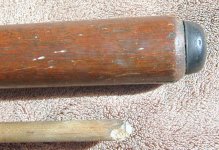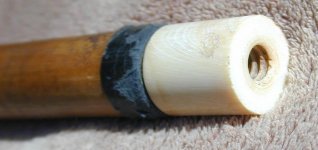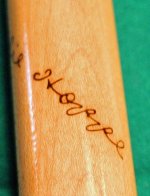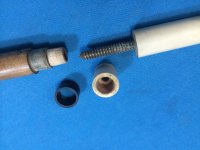You are using an out of date browser. It may not display this or other websites correctly.
You should upgrade or use an alternative browser.
You should upgrade or use an alternative browser.
Early Hoppe
- Thread starter ImetMosconi
- Start date
Not without a picture of the weight stamp or decal.
That is almost certainly an old house cue conversion. Brunswick dealers did them at their shops, as well as the Brunswick factory by request.
A good sunlit closeup of the veneers will help.
Neat cue, but not super collectible beyond $300. Might bag $400.
Is it a 5/16x14 pin?
That is almost certainly an old house cue conversion. Brunswick dealers did them at their shops, as well as the Brunswick factory by request.
A good sunlit closeup of the veneers will help.
Neat cue, but not super collectible beyond $300. Might bag $400.
Is it a 5/16x14 pin?
ImetMosconi
Registered
More info on early Hoppe
The cue measures 58" to the base of the broken tip, the shaft is 11mm at that point. The Hoppe signature is faint with the older version of the "p"'s, and appears to have a reddish ink fill. The weight stamp (21) is between the points. The points are very sharp, without the later purple color. see pics attached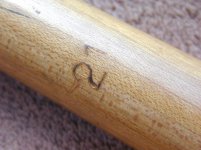
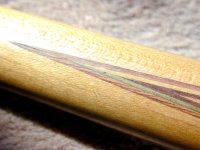
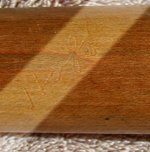
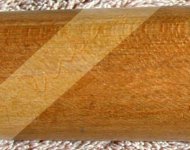
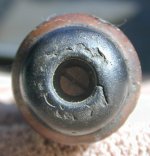
The cue measures 58" to the base of the broken tip, the shaft is 11mm at that point. The Hoppe signature is faint with the older version of the "p"'s, and appears to have a reddish ink fill. The weight stamp (21) is between the points. The points are very sharp, without the later purple color. see pics attached





ImetMosconi
Registered
re: no decal on this cue
There is no evidence of the cue having been refinished. There is no sign of there ever having been a decal - there's no outline or difference in color where a decal would have been.
There is no evidence of the cue having been refinished. There is no sign of there ever having been a decal - there's no outline or difference in color where a decal would have been.
The veneers and weight stamp are late, actually.
That is no older than the late 1950s, and was probably done by some random cuemaker.
Not sure on the signature, but I have never seen that stamp on an older cue.
The veneers are just faded, but they are later veneers as well. Could be a purchased blank from Brunswick that someone turned down.
That is no older than the late 1950s, and was probably done by some random cuemaker.
Not sure on the signature, but I have never seen that stamp on an older cue.
The veneers are just faded, but they are later veneers as well. Could be a purchased blank from Brunswick that someone turned down.
ImetMosconi
Registered
ImetMosconi
Registered
There were two versions of the Hoppe signature.The shape of "p" letters in the signature of this cue are the earlier 40's date.
ImetMosconi
Registered
There absolutely no purple veneers on this cue.
There absolutely no purple veneers on this cue.
Those outer veneers are purple, just faded. I will send photos of several other cues with identical fading
There absolutely no purple veneers on this cue.
idea is right - veneers faded over time.
The faint sig is most likely due to sanding - as the lack of any trace of a label.
My best guess would be a Titlist 1pc, not a Hoppe - "converted" at some point
and the original big clunky bumper was replaced by a more standard house cue bumper.
About the shaft:
Hoppe's own Rambow had the pin in the shaft, as was the standard for Brunswick cues untill
the late 1930s-ish. This shaft may have been made at the time of the conversion,
or perhaps was from an older brunswick, and was used. Many a house cue was busted
over the years by players who missed the money ball
--------------------------------------------------------------------------------------------------------------------------
Upon further review - I like my fitted the butt to an existing shaft even more.
The pin is a 5/16 - 12, which identifies it as from a Katz cue.
Dale
Last edited:
ImetMosconi
Registered
early hope signature
Thanks for the responses! Under better light the faded purple is indeed apparent. I am not informed enough to comment on the Katz shaft suggestion. But I still have questions...
Was there ever a Brunswick one piece or two piece cue with a "Willie Hoppe" signature on the forearm that was not a Hoppe?
Will commentors please review the image I posted above showing the faint signature on this cue and compare it to the pictures of the two versions of the Hoppe signature as shown online at Vintage Cues for You, under the "Looking Back" section.
Thanks again.
Thanks for the responses! Under better light the faded purple is indeed apparent. I am not informed enough to comment on the Katz shaft suggestion. But I still have questions...
Was there ever a Brunswick one piece or two piece cue with a "Willie Hoppe" signature on the forearm that was not a Hoppe?
Will commentors please review the image I posted above showing the faint signature on this cue and compare it to the pictures of the two versions of the Hoppe signature as shown online at Vintage Cues for You, under the "Looking Back" section.
Thanks again.
Attachments
Thanks for the responses! Under better light the faded purple is indeed apparent. I am not informed enough to comment on the Katz shaft suggestion. But I still have questions...
Was there ever a Brunswick one piece or two piece cue with a "Willie Hoppe" signature on the forearm that was not a Hoppe?
Will commentors please review the image I posted above showing the faint signature on this cue and compare it to the pictures of the two versions of the Hoppe signature as shown online at Vintage Cues for You, under the "Looking Back" section.
Thanks again.
No, it is a Willie Hoppe Titlist one piece cue, as opposed to the Professional two piece cue. The label has been sanded off.
ImetMosconi
Registered
AZbilliard forum, Thanks!
AZ forum members - Thanks for your help in identifying this cue.
I also have my own Titlist conversion which was made for me at Whitehead and Zimmerman in San Francisco in 1970 (pictures below). The cue was built to the specifications given by Mosconi in his 2nd instruction book (the one where he’s wearing a powder blue sport coat on the cover). Having traded the original shaft along with $20 to a friend for taking my statistics final, I asked another games room player who was going to So Cal to pick up a cue he’d ordered from a young cue maker, to have him make me a shaft too. This cue maker named his cues after his daughter - Gina Cues! (pictures below)
I discovered pool as a freshman at Cal Berkeley in 1968. The Student Union games room was an impressive place...12 Crown 4 1/2 x 9’s, 2 snooker tables - 5x10 and two three cushion tables.
Memorable moments include:
Seeing Bob Jewett, in his Air Force uniform, unwrap his his newly arrived Balabushka and hitting it for the first time on table #1.
Meeting a very ardent newbie named Phil Cappelle, to whom I recall suggesting the closed hand bridge.
Riding in Phil’s VW bug with others from the games room to see Willie Mosconi give an exhibition at Cochran’s. And afterwards standing in line to shake his hand. That’s how “I met Mosconi”!
Best Regards,
George Tucker

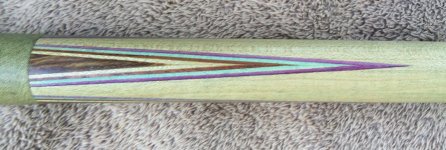

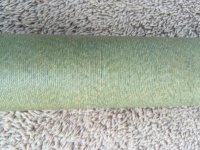

AZ forum members - Thanks for your help in identifying this cue.
I also have my own Titlist conversion which was made for me at Whitehead and Zimmerman in San Francisco in 1970 (pictures below). The cue was built to the specifications given by Mosconi in his 2nd instruction book (the one where he’s wearing a powder blue sport coat on the cover). Having traded the original shaft along with $20 to a friend for taking my statistics final, I asked another games room player who was going to So Cal to pick up a cue he’d ordered from a young cue maker, to have him make me a shaft too. This cue maker named his cues after his daughter - Gina Cues! (pictures below)
I discovered pool as a freshman at Cal Berkeley in 1968. The Student Union games room was an impressive place...12 Crown 4 1/2 x 9’s, 2 snooker tables - 5x10 and two three cushion tables.
Memorable moments include:
Seeing Bob Jewett, in his Air Force uniform, unwrap his his newly arrived Balabushka and hitting it for the first time on table #1.
Meeting a very ardent newbie named Phil Cappelle, to whom I recall suggesting the closed hand bridge.
Riding in Phil’s VW bug with others from the games room to see Willie Mosconi give an exhibition at Cochran’s. And afterwards standing in line to shake his hand. That’s how “I met Mosconi”!
Best Regards,
George Tucker





AZ forum members - Thanks for your help in identifying this cue.
I also have my own Titlist conversion which was made for me at Whitehead and Zimmerman in San Francisco in 1970 (pictures below). The cue was built to the specifications given by Mosconi in his 2nd instruction book (the one where he’s wearing a powder blue sport coat on the cover). Having traded the original shaft along with $20 to a friend for taking my statistics final, I asked another games room player who was going to So Cal to pick up a cue he’d ordered from a young cue maker, to have him make me a shaft too. This cue maker named his cues after his daughter - Gina Cues! (pictures below)
I discovered pool as a freshman at Cal Berkeley in 1968. The Student Union games room was an impressive place...12 Crown 4 1/2 x 9’s, 2 snooker tables - 5x10 and two three cushion tables.
Memorable moments include:
Seeing Bob Jewett, in his Air Force uniform, unwrap his his newly arrived Balabushka and hitting it for the first time on table #1.
Meeting a very ardent newbie named Phil Cappelle, to whom I recall suggesting the closed hand bridge.
Riding in Phil’s VW bug with others from the games room to see Willie Mosconi give an exhibition at Cochran’s. And afterwards standing in line to shake his hand. That’s how “I met Mosconi”!
Best Regards,
George Tucker
View attachment 400229
View attachment 400230
View attachment 400231
View attachment 400232
View attachment 400233
I think I recognize this cue... is that an early Gina shaft? I believe we may have played at the Broken Rack a while ago.
ImetMosconi
Registered
Early hoppe
We may have played. I'm at the Broken Rack often!
We may have played. I'm at the Broken Rack often!
ImetMosconi
Registered
re: mtg at the Broken Rack
Perhaps. I'm at the Broken Rack often! It's a great place...good people, good food and a great playing set up.
Perhaps. I'm at the Broken Rack often! It's a great place...good people, good food and a great playing set up.
ImetMosconi
Registered
More photos of this old Hoppe
I live in the Bay Area, so a friend suggested calling Richard Chudy to look at this cue.
Mr. Chudy very kindly allowed me to visit him. Although this type of cue is vastly different from the beautiful works of art he builds, he did comment that the points near the joint were very nice and the ones at the back were very good as well.
While examining the joint, he was able to twist off the ivory threaded sleeve, revealing the turning marks seen in the photos below. Given the 59" overall length (with the missing ferrule it would be 60") and the small tip size, he suggested it could have been a custom order snooker cue. He also suggested that the stiff threading of the shaft was due to swelling of the wood tapped into the butt. He also commented the butt rolled straight.
Since the shaft was badly warped I had a machinist friend remove the brass pin and put it the shaft of one of my one piece cues. By using the phenoilc collar on the shaft under the ivory joint I was able to thread the cue together, to see how it played. I was very pleased. I like heavy cues with big butts (the 1970 Titilist conversion made for me by Whitehead and Zimmerman is one as well). The cue with this temporay shaft weighs 21.5oz and is 58" long. The feel of the strike is solid, and the sound is sweet - like the sound of persimmon on balata (for those fortunate to have heard that).
These guys are right, an early Titlist one piece converted. The purple is likely real purpleheart (not a dyed veneer), which turns red or rusty brown as it oxidizes over time. Cue is ripe for an updating if it's straight.
I live in the Bay Area, so a friend suggested calling Richard Chudy to look at this cue.
Mr. Chudy very kindly allowed me to visit him. Although this type of cue is vastly different from the beautiful works of art he builds, he did comment that the points near the joint were very nice and the ones at the back were very good as well.
While examining the joint, he was able to twist off the ivory threaded sleeve, revealing the turning marks seen in the photos below. Given the 59" overall length (with the missing ferrule it would be 60") and the small tip size, he suggested it could have been a custom order snooker cue. He also suggested that the stiff threading of the shaft was due to swelling of the wood tapped into the butt. He also commented the butt rolled straight.
Since the shaft was badly warped I had a machinist friend remove the brass pin and put it the shaft of one of my one piece cues. By using the phenoilc collar on the shaft under the ivory joint I was able to thread the cue together, to see how it played. I was very pleased. I like heavy cues with big butts (the 1970 Titilist conversion made for me by Whitehead and Zimmerman is one as well). The cue with this temporay shaft weighs 21.5oz and is 58" long. The feel of the strike is solid, and the sound is sweet - like the sound of persimmon on balata (for those fortunate to have heard that).
Attachments
Last edited:
ImetMosconi
Registered
I'm not sure. My big fear is I'll end up liking it more than my life long friend, my Titilist conversion form Whitehead and Zimmerman.


